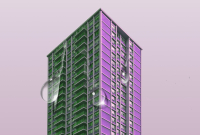How 100,000 trees will help shade Vancouver from extreme heat

Nearly three years after British Columbia’s deadly heat dome, its largest municipality says it will plant 100,000 trees to protect people from the effects of extreme heat.
On Wednesday, Vancouver city council passed a motion instructing city staff to create a timeline and budget to plant 100,000 native and climate-resilient trees across the city. The motion specifies that the trees will be planted in neighbourhoods that have less tree coverage, which is shown to cause warmer temperatures.
During the 2021 heat dome, more than 600 people in B.C. died due to extreme heat. Researchers from the B.C. Centre for Disease Control (BCCDC) found that women, along with people who were elderly, poor and isolated made up a disproportionate percentage of those who died during the event.
It also became clear that areas far from water and without trees or other green space near their home had the highest mortality rates. A five per cent increase in tree canopy within a 100 metre radius of a person’s home was found to decrease the risk of death by about 10 per cent.
“Science shows that tree canopy actually mitigates against that excess heat and actually brings down air temperatures considerably, and so that was one of the motivating reasons,” explained Green Party Coun. Adriane Carr, who brought forward the motion with Coun. Christine Boyle.
In Vancouver, the Downtown Eastside is the least forested area of the city. The south and east sides also have less tree canopy than the wealthier western neighbourhoods. A 2022 report from Nature Canada found trees are inequitably distributed across the city: specifically, areas of lower income and higher percentages of BIPOC residents have less tree coverage.
Urban Heat Islands
Vancouver’s motion is welcome news to the David Suzuki Foundation.
Cameron Esler, the organization’s community engagement organizer for sustainable communities, notes that many cities want to expand their tree canopies. Vancouver already had a target to increase the city’s tree canopy by 30 per cent by 2050, while Toronto aims to up its tree coverage by 40 per cent by that time by planting 120,000 trees a year.
However, Elser said this week’s motion is part of “a bigger movement, an important one, to ensure that tree canopy is equally distributed so that it can protect the communities that need it most.”
While rural residents also feel the heat, city centres have unique conditions that draw in and maintain heat, Elser explained. Vancouverites, Torontonians and Montrealers live in “urban heat islands” that are formed when concrete and asphalt replace grass and dirt. Buildings and concrete absorb radiation and release it as heat, making cities up to 12 degrees hotter than their rural counterparts at night — and an inability to cool down at night is one of the major drivers of deaths during heat emergencies. Heat is also more intense in apartments and condos than houses, which usually allow cross breezes and have more shade.
Vancouver’s motion fits into city jurisdiction, while other steps like making buildings and homes cooler through heat pump and air conditioning programs are often administered through provincial or federal governments, such as B.C.’s free air conditioning program that supplied 8,000 units last year. However, cities such as New Westminster and View Royal are considering rules for landlords, which would require them to keep rental units below a certain temperature.
The benefits of Vancouver’s 100,000 trees will come into effect years into the future, as cities continue to warm. While climate change has fueled recent demand for heat pumps and AC units in areas of Canada where cooling wasn’t previously the norm, America’s hottest cities are now seeing even AC units not keeping people safe indoors during the hottest days.
The vulnerability of people in their homes emphasized the need for cities to provide cooling centres during heatwaves along with increasing green space, Elser explained.
Details are still forthcoming about Vancouver’s 100,000 trees. Elser said there will need to be sufficient maintenance once they’re planted if they are to survive long enough to provide benefits. Carr notes that Vancouver is currently losing trees in part due to increased drought conditions, which have killed young trees more frequently. Part of Vancouver’s motion includes support for a program that would ask residents to sign up to water trees, especially newly planted ones.
“We're very encouraged to see neighborhoods and people and adopt-a-tree programs getting involved, but we also want [to ensure] those trees are planted and watered correctly,” noted Elser, who said that will require ample work and resources from the city.






Comments